Study of [Bmim]Cl/LiCl Co-Solvent Dissolution of Waste Wool
Abstract
:1. Introduction
2. Materials and Methods
2.1. LiCl/[Bmim]Cl Solution Configuration
2.2. Dissolution and Regeneration of Waste Wool
2.3. Performance Testing
3. Results
3.1. Solubility of LiCl in [Bmim]Cl
3.2. Impact of LiCl Content on the Dissolution Process of Waste Wool
3.3. Impact of Diverse Dissolution Durations on Waste Wool’s Solubility and Molecular Weight
3.4. Impact of the Dissolution Temperature on the Waste Wool’s Dissolution Process
- (1)
- Influence of the Dissolution Temperature on the Waste Wool’s Dissolution Rate
- (2)
- Impact of the Dissolution Temperature on Molecular Weight
3.5. X-ray Diffraction Test Results Analysis
3.6. Cites an Analysis of the X Small-Angle Scattering Test Results
3.7. Consists of an Analysis of Infrared Spectroscopy Results
3.8. Presents the Atomic Force Microscopy
4. Conclusions
Author Contributions
Funding
Institutional Review Board Statement
Informed Consent Statement
Data Availability Statement
Conflicts of Interest
References
- Martin, M.; Herlaar, S. Environmental and social performance of valorizing waste wool for sweater production. Sustain. Prod. Consum. 2021, 25, 425–438. [Google Scholar] [CrossRef]
- Sun, Y.; Li, B.; Zhang, Y. The progress and prospect for sustainable development of waste wool resources. Text. Res. J. 2023, 93, 468–485. [Google Scholar] [CrossRef]
- Zhang, C.; Xia, L.; Zhang, J. Utilization of waste wool fibers for fabrication of wool powders and keratin: A review. J. Leather Sci. Eng. 2020, 2, 1–15. [Google Scholar] [CrossRef]
- Cataldi, P.; Condurache, O.; Spirito, D. Keratin-graphene nanocomposite: Transformation of waste wool in electronic devices. ACS Sustain. Chem. Eng. 2019, 7, 12544–12551. [Google Scholar] [CrossRef]
- Giteru, S.G.; Ramsey, D.H.; Hou, Y. Wool keratin as a novel alternative protein: A comprehensive review of extraction, purification, nutrition, safety, and food applications. Compr. Rev. Food Sci. Food Saf. 2023, 22, 643–687. [Google Scholar] [CrossRef]
- Ma, H.; Shen, J.; Cao, J. Fabrication of wool keratin/polyethylene oxide nano-membrane from wool fabric waste. J. Clean. Prod. 2017, 161, 357–361. [Google Scholar] [CrossRef]
- Patankar, K.C.; Maiti, S.; Singh, G.P. Chemically modified wool waste keratin for flame retardant cotton finishing. Clean. Eng. Technol. 2021, 5, 100319. [Google Scholar] [CrossRef]
- Figoli, A.; Ursino, C.; Sanchez Ramirez, D.O. Fabrication of electrospun keratin nanofiber membranes for air and water treatment. Polym. Eng. Sci. 2019, 59, 1472–1478. [Google Scholar] [CrossRef]
- El-Sayed, H.; Abou-Taleb, M. Polypropylene fabric of durable hydrophilic character using plasma-mediated surface coating with keratin. J. Adhes. Sci. Technol. 2023, 1–15. [Google Scholar] [CrossRef]
- Basuoni, A.S.; Sabaa, M.W.; Mohamed, R.R. An eco-friendly strategy for grafting keratin onto polyacrylonitrile fabrics using bi-functional amino acids as coupling agents. J. Adhes. Sci. Technol. 2023, 1–16. [Google Scholar] [CrossRef]
- Kooshamoghadam, N.; Zohoori, S.; Bekrani, M. Enhancing physical properties of viscose by preparing viscose/keratin/nano ZnO composite fabric. J. Nat. Fibers 2022, 19, 4846–4853. [Google Scholar] [CrossRef]
- Dickerson, M.B.; Sierra, A.A.; Bedford, N.M. Keratin-based antimicrobial textiles, films, and nanofibers. J. Mater. Chem. B 2013, 1, 5505–5514. [Google Scholar] [CrossRef]
- Khalilipourroodi, K.; Dadashian, F.; Solouk, A. Effect of extraction method on properties of feather keratin grafted modified cotton nonwoven fabric for biomedical applications. J. Ind. Text. 2022, 51, 2558S–2575S. [Google Scholar] [CrossRef]
- Zhang, Z.; Nie, Y.; Zhang, Q. Quantitative change in disulfide bonds and microstructure variation of regenerated wool keratin from various ionic liquids. ACS Sustain. Chem. Eng. 2017, 5, 2614–2622. [Google Scholar] [CrossRef]
- Huson, M.G. Properties of wool. In Handbook of Properties of Textile and Technical Fibres; Woodhead Publishing: Cambridge, UK, 2018; pp. 59–103. [Google Scholar]
- Das, S. Physical and Chemical Properties of Wool. Sheep Wool Mutton Prod. Value Addit. 2021, 7, 91–95. [Google Scholar]
- Hearle, J.W.S. A critical review of the structural mechanics of wool hair fibers. Int. J. Biol. Macromol. 2000, 27, 123–138. [Google Scholar] [CrossRef] [PubMed]
- Rajabinejad, H.; Zoccola, M.; Patrucco, A. Physicochemical properties of keratin extracted from wool by various methods. Text. Res. J. 2018, 88, 2415–2424. [Google Scholar] [CrossRef]
- Sehgal, P.K. Studies on solubilized keratins from poultry feathers. Leather Sci. 1986, 33, 333–343. [Google Scholar]
- Toran-Diaz, I.; Jain, V.K.; Allais, J.J. Effect of acid or enzymatic hydrolysis on ethanol production by zymomonas mobilis growing on Jerusalem artichoke juice. Biotechnol. Lett. 1985, 7, 527–530. [Google Scholar] [CrossRef]
- Zhang, J.; Li, Y.; Li, J. Isolation and characterization of biofunctional keratin particles extracted from wool wastes. Powder Technol. 2013, 246, 356–362. [Google Scholar] [CrossRef]
- Eslahi, N.; Dadashian, F.; Nejad, N.H. Optimization of Enzymatic Hydrolysis of Wool Fiber for Nanoparticles Production Using Response Surface Methodology. Adv. Powder Technol. 2013, 24, 416–426. [Google Scholar] [CrossRef]
- Mutate, H.; Shigematsu, M.; Abe, K. Molten urea as a novel dissolving solvent for wool and other animal proteins. Sen’i Gakkaishi 2010, 66, 56–159. [Google Scholar]
- Cardamone, J.M. Investigating the microstructure of keratin extracted from wool: Peptide sequence (MALDI-TOF /TOF) and protein conformation (FTIR). J. Mol. Struct. 2010, 969, 97–105. [Google Scholar] [CrossRef]
- Zeng, C.H.; Lu, Q. Study on the recovery of waste wool by combining reduction and metallic salt methods. Adv. Mater. Res. 2014, 881, 551–555. [Google Scholar] [CrossRef]
- Li, B.; Huang, C.; Yang, X. Preparation and characterization of electrospun wool keratin/polyethylene oxide nanofibers for air filtration applications. Dig. J. Nanomater. Biostructures DJNB 2017, 12, 293–301. [Google Scholar]
- Sajura; Zhao, X.; Miyag, A.; Tsuyoshi, W.A.; Mitsuhiko, K. Mechanism of wool keratin extraction by molten urea method. South Agric. Sci. 2020, 49, 174–180. [Google Scholar]
- Sun, Z.; Li, H.; Sun, M.; Liang, Z. Study on resolubility of recovered wool keratin Textile. Sci. Technol. 2019, 47, 54–59. [Google Scholar]
- Pu, Y.; Jiang, N.; Ragauskas, A.J. Ionic liquid as a green solvent for lignin. J. Wood Chem. Technol. 2007, 27, 23–33. [Google Scholar] [CrossRef]
- Welton, T. Ionic liquids in green chemistry. Green Chem. 2011, 13, 225. [Google Scholar] [CrossRef]
- Mallakpour, S.; Dinari, M. Ionic liquids as green solvents: Progress and prospects. Green Solvents II Prop. Appl. Ion. Liq. 2004, 41, 41–43. [Google Scholar]
- Plechkova, N.V.; Seddon, K.R. Ionic liquids: “designer” solvents for green chemistry. In Methods and Reagents for Green Chemistry: An Introduction; John Wiley & Sons, Inc.: Hoboken, NJ, USA, 2007; pp. 103–130. [Google Scholar]
- Earle, M.J.; Seddon, K.R. Ionic liquids. Green solvents for the future. Pure Appl. Chem. 2000, 72, 1391–1398. [Google Scholar] [CrossRef]
- Hussey, C.L. Room temperature haloaluminate ionic liquids. Novel solvents for transition metal solution chemistry. Pure Appl. Chem. 1988, 60, 1763–1772. [Google Scholar] [CrossRef]
- Marsh, K.N.; Deev, A.; Wu, A.C.T. Room temperature ionic liquids as replacements for conventional solvents–A review. Korean J. Chem. Eng. 2002, 19, 357–362. [Google Scholar] [CrossRef]
- Tonin, C.; Zoccola, M.; Aluigi, A.; Varesano, A.; Montarsolo, A.; Vineis, C.; Zimbardi, F. Study on the conversion of wool keratin by steam explosion. Biomacromolecules 2006, 7, 3499–3504. [Google Scholar] [CrossRef] [PubMed]
- Peng, Z.; Zhang, J.; Du, G. Keratin waste recycling based on microbial degradation: Mechanisms and prospects. ACS Sustain. Chem. Eng. 2019, 7, 9727–9736. [Google Scholar] [CrossRef]
- Qiu, J.; Wilkens, C.; Barrett, K. Microbial enzymes catalyzing keratin degradation: Classification, structure, function. Biotechnol. Adv. 2020, 44, 107607. [Google Scholar] [CrossRef]
- Holkar, C.R.; Jain, S.S.; Jadhav, A.J. Valorization of keratin based waste. Process Saf. Environ. Prot. 2018, 115, 85–98. [Google Scholar] [CrossRef]
- Xie, H.; Li, S.; Zhang, S. Ionic liquids as novel solvents for the dissolution and blending of wool keratin fibers. Green Chem. 2005, 7, 606–608. [Google Scholar] [CrossRef]
- Idris, A.; Vijayaraghavan, R.; Rana, U.A. Dissolution of feather keratin in ionic liquids. Green Chem. 2013, 15, 525–534. [Google Scholar] [CrossRef]
- Idris, A.; Vijayaraghavan, R.; Rana, U.A. Dissolution and regeneration of wool keratin in ionic liquids. Green Chem. 2014, 16, 2857–2864. [Google Scholar] [CrossRef]
- Ghosh, A.; Clerens, S.; Deb-Choudhury, S. Thermal effects of ionic liquid dissolution on the structures and properties of regenerated wool keratin. Polym. Degrad. Degrad. Degrad. Stab. 2014, 108, 108–115. [Google Scholar] [CrossRef]
- Salama, A.; Guarino, V. Ionic liquids to process silk fibroin and wool keratin for bio-sustainable and biomedical applications. J. Polym. Environ. 2022, 30, 4961–4977. [Google Scholar] [CrossRef]
- Xu, A.; Wang, J.; Wang, H. Effects of anionic structure and lithium salts addition on the dissolution of cellulose in 1-butyl-3-methylimidazolium-based ionic liquid solvent systems. Green Chem. 2010, 12, 268–275. [Google Scholar] [CrossRef]
- Zhang, Q.; Song, J.; Liao, W.; Wang, L.; Fu, Z.; Chen, B. Effect of lithium chloride on spinning of cellulose/ionic liquid concentrated solution. J. Henan Inst. Eng. 2014, 26, 6–10. [Google Scholar]
- Athieu, M.; Catana, D.A.; Carlos, V.G. Influence of water on the dissolution of cellulose in selected ionic liquids. Cellulose 2009, 16, 207–215. [Google Scholar]
- Ejeian, M.; Entezari, A.; Wang, R.Z. Solar powered atmospheric water harvesting with enhanced LiCl/MgSO4/ACF composite. Appl. Therm. Eng. 2020, 176, 115396. [Google Scholar] [CrossRef]
- Zhang, C.; Liu, R.; Xiang, J. Dissolution mechanism of cellulose in N, N-dimethylacetamide/lithium chloride: Revisiting through molecular interactions. J. Phys. Chem. B 2014, 118, 9507–9514. [Google Scholar] [CrossRef]
- Southan, M.; MacRitchie, F. Molecular weight distribution of wheat proteins. Cereal Chem. 1999, 76, 827–836. [Google Scholar] [CrossRef]
- Mittal, G.; Sahana, D.K.; Bhardwaj, V. Estradiol loaded PLGA nanoparticles for oral administration: Effect of polymer molecular weight and copolymer composition on release behavior in vitro and in vivo. J. Control. Release 2007, 119, 77–85. [Google Scholar] [CrossRef]
- Goetz, H.; Kuschel, M.; Wulff, T. Comparison of selected analytical techniques for protein sizing, quantitation and molecular weight determination. J. Biochem. Biophys. Methods 2004, 60, 281–293. [Google Scholar] [CrossRef]
- Cao, G.; Rong, M.Z.; Zhang, M.Q. Continuous high-content keratin fibers with balanced properties derived from wool waste. ACS Sustain. Chem. Eng. 2020, 8, 18148–18156. [Google Scholar] [CrossRef]
- Hameed, N.; Guo, Q. Natural wool/cellulose acetate blends regenerated from the ionic liquid 1-butyl-3-methylimidazolium chloride. Carbohydr. Polym. 2009, 78, 999–1004. [Google Scholar] [CrossRef]
- Li, R.; Wang, D. Preparation of regenerated wool keratin films from wool keratin–ionic liquid solutions. J. Appl. Polym. Sci. 2013, 127, 2648–2653. [Google Scholar] [CrossRef]
- Svergun, D.I.B.C.; Barberato, C.; Koch, M.H. CRYSOL—A program to evaluate X-ray solution scattering of biological macromolecules from atomic coordinates. J. Appl. Cryst. 1995, 28, 768–773. [Google Scholar] [CrossRef]
- Parvulescu, V.I.; Hardacre, C. Catalysis in ionic liquids. Chem. Rev. 2007, 107, 2615–2665. [Google Scholar] [CrossRef] [PubMed]
- Greaves, T.; Drummond, C. Protic ionic liquids: Properties and applications. Chem. Rev. 2008, 208, 206–237. [Google Scholar] [CrossRef]
- Diz, M.; Jocic, D.; Infante, M. Reaction of a new thiol cationic surfactant with bunte salt in wool fibers. Text. Res. J. 1997, 67, 486–493. [Google Scholar] [CrossRef]
- Gomez, N.; Julia, M.R.; Lewis, D.M. The use of FTIR to investigate modifications to wool treated with sodium sulphite and cationic protein hydrolysate. J. Soc. Dye. Colour. 1995, 111, 281–284. [Google Scholar] [CrossRef]
- Stahl, W.H.; Mcque, B.; Siu, R.G.H. Decomposition of cystine and wool by treatment in the ball mill and autoclave. J. Biol. Chem. 1949, 177, 69–73. [Google Scholar] [CrossRef]
- Alexander, P.; Fox, M.; Hudson, R.F. The reaction of oxidizing agents with wool. Biochem. J. 1951, 49, 129–138. [Google Scholar] [CrossRef]
- Zhao, J.; Sun, F.; Li, Y. Modification of gel properties of soy protein isolate by freeze-thaw cycles are associated with changes of molecular force involved in the gelation. Process Biochem. 2016, 52, 200–208. [Google Scholar] [CrossRef]
- Lin, M.; Tay, S.H.; Yang, H. Replacement of eggs with soybean protein isolates and polysaccharides to prepare yellow cakes suitable for vegetarians. Food Chem. 2017, 229 (Suppl. C), 663–673. [Google Scholar] [CrossRef] [PubMed]
- Guo, F.X.; Xiong, Y.L.; Qin, F.; Jian, H.J.; Huang, X.L.; Chen, J. Examination of the causes of instability of soy protein isolate during storage through probing of the heat-induced aggregation. J. Am. Oil Chem. Soc. 2015, 92, 1075–1084. [Google Scholar] [CrossRef]
- Rodriguez-Nogales, J.M.; Garcia, M.C.; Marina, M.L. High-performance liquid chromatography and capillary electrophoresis for the analysis of maize proteins. J. Sep. Sci. 2006, 29, 197–210. [Google Scholar] [CrossRef]
- Vu, T.; Xue, Y.; Vuong, T. Comparative study of ultrasonication-induced and naturally self-assembled silk fibroin-wool keratin hydrogel biomaterials. Int. J. Mol. Sci. 2016, 17, 1497. [Google Scholar] [CrossRef]
- Lü, X.; Cui, S. Wool keratin-stabilized silver nanoparticles. Bioresour. Technol. 2010, 101, 4703–4707. [Google Scholar] [CrossRef]
- Zeng, W.; Yu, D.; Tang, Y. Wool keratin photolithography as an eco-friendly route to fabricate protein microarchitectures. ACS Appl. Bio Mater. 2020, 3, 2891–2896. [Google Scholar] [CrossRef]
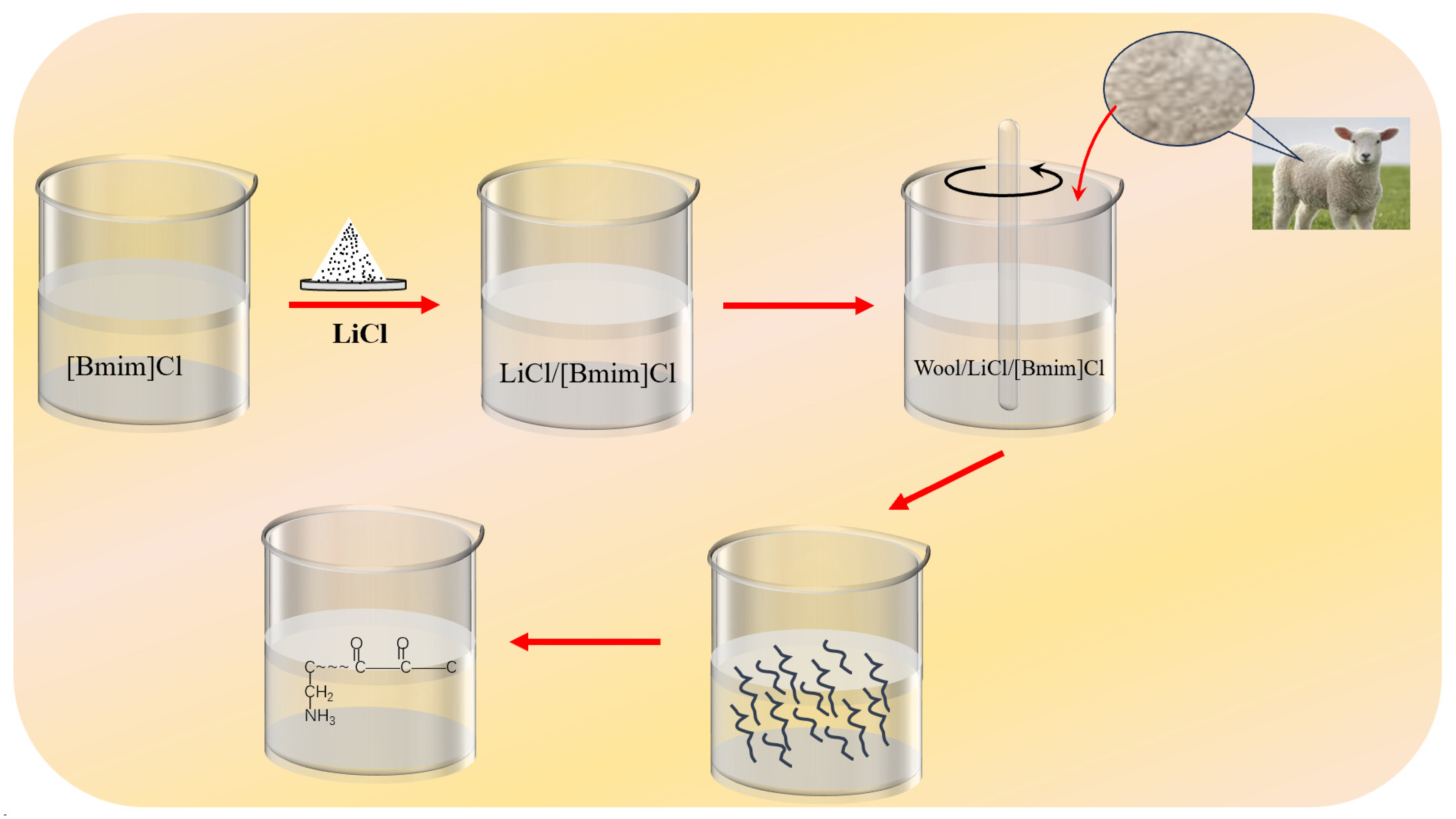


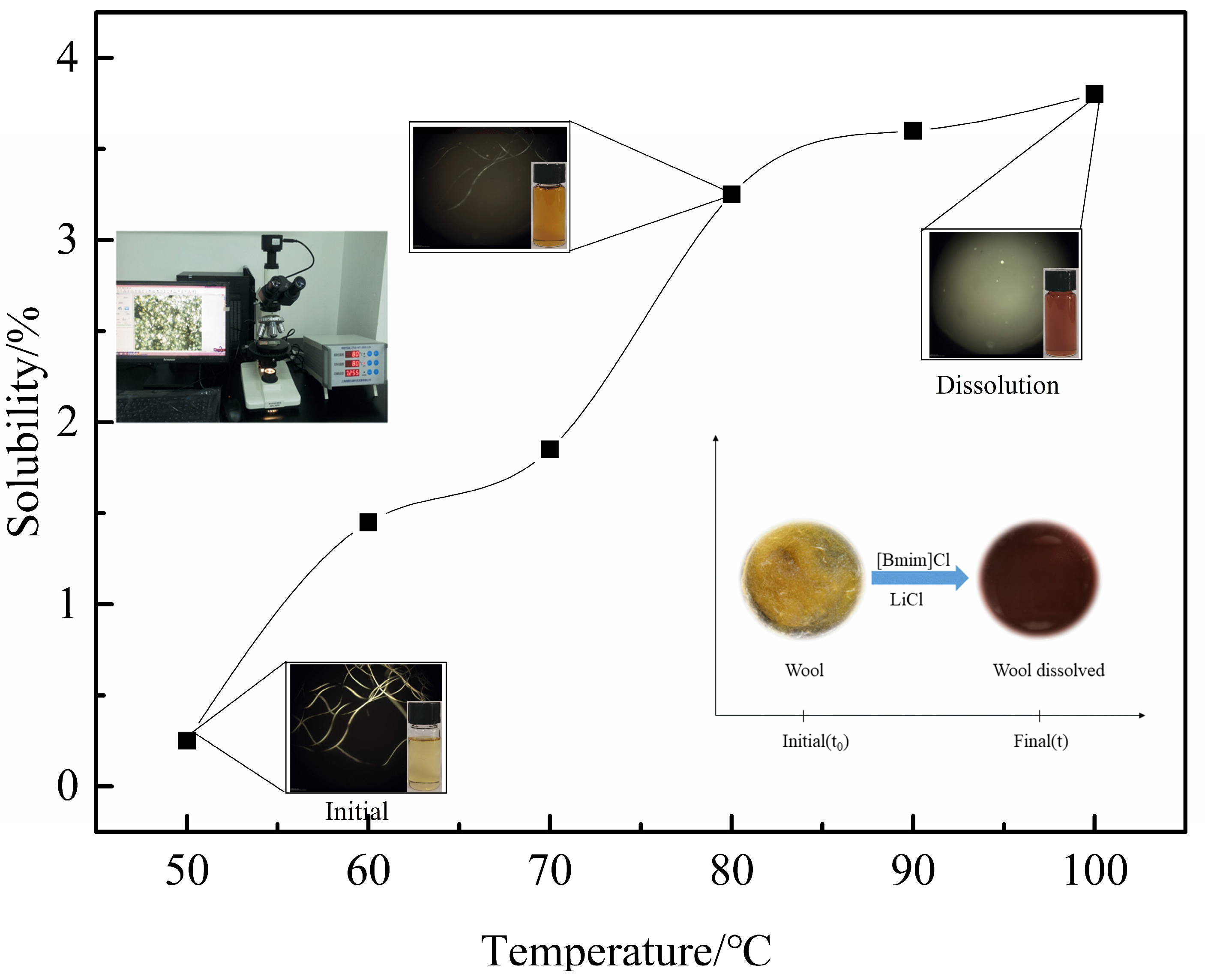
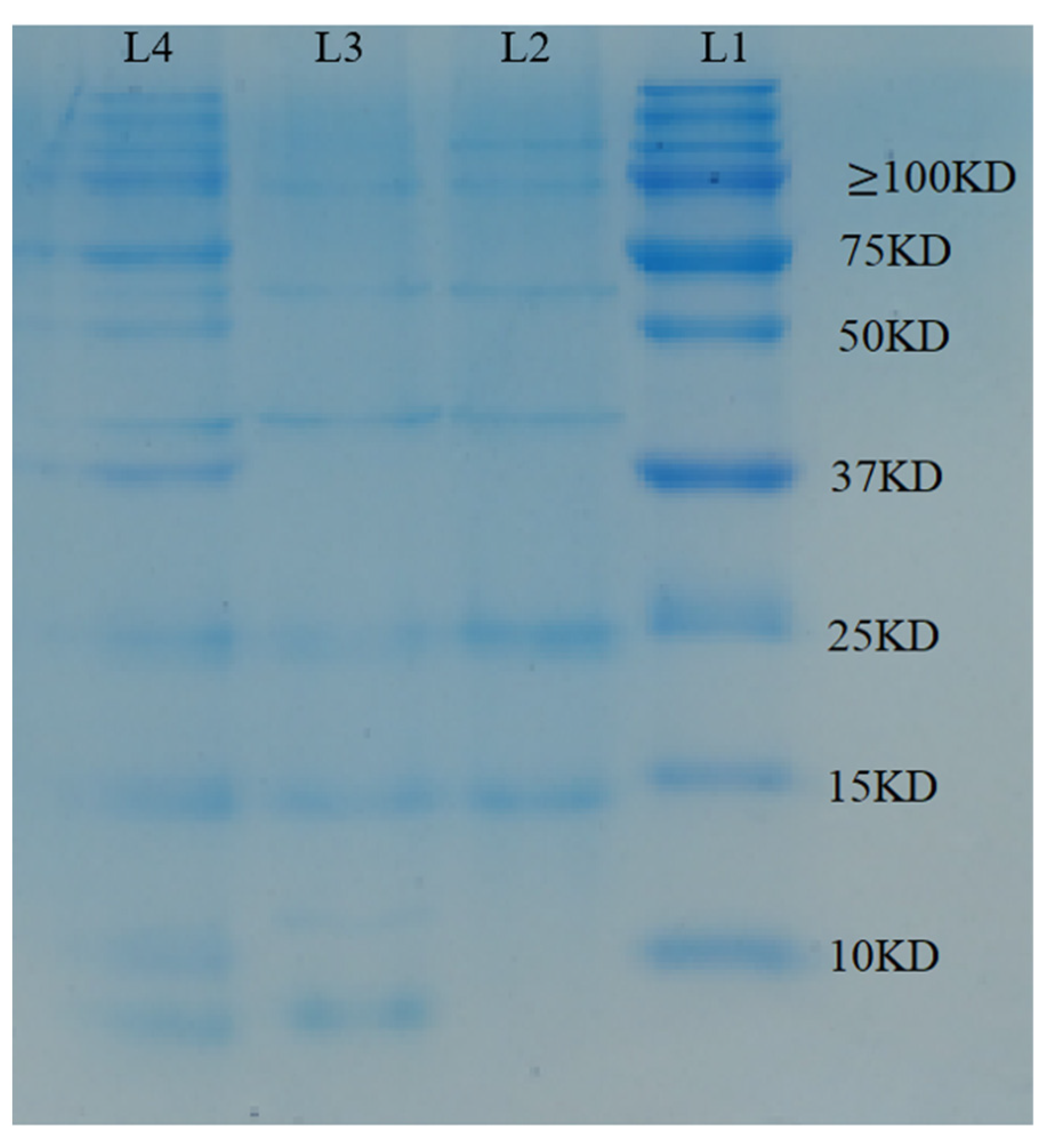
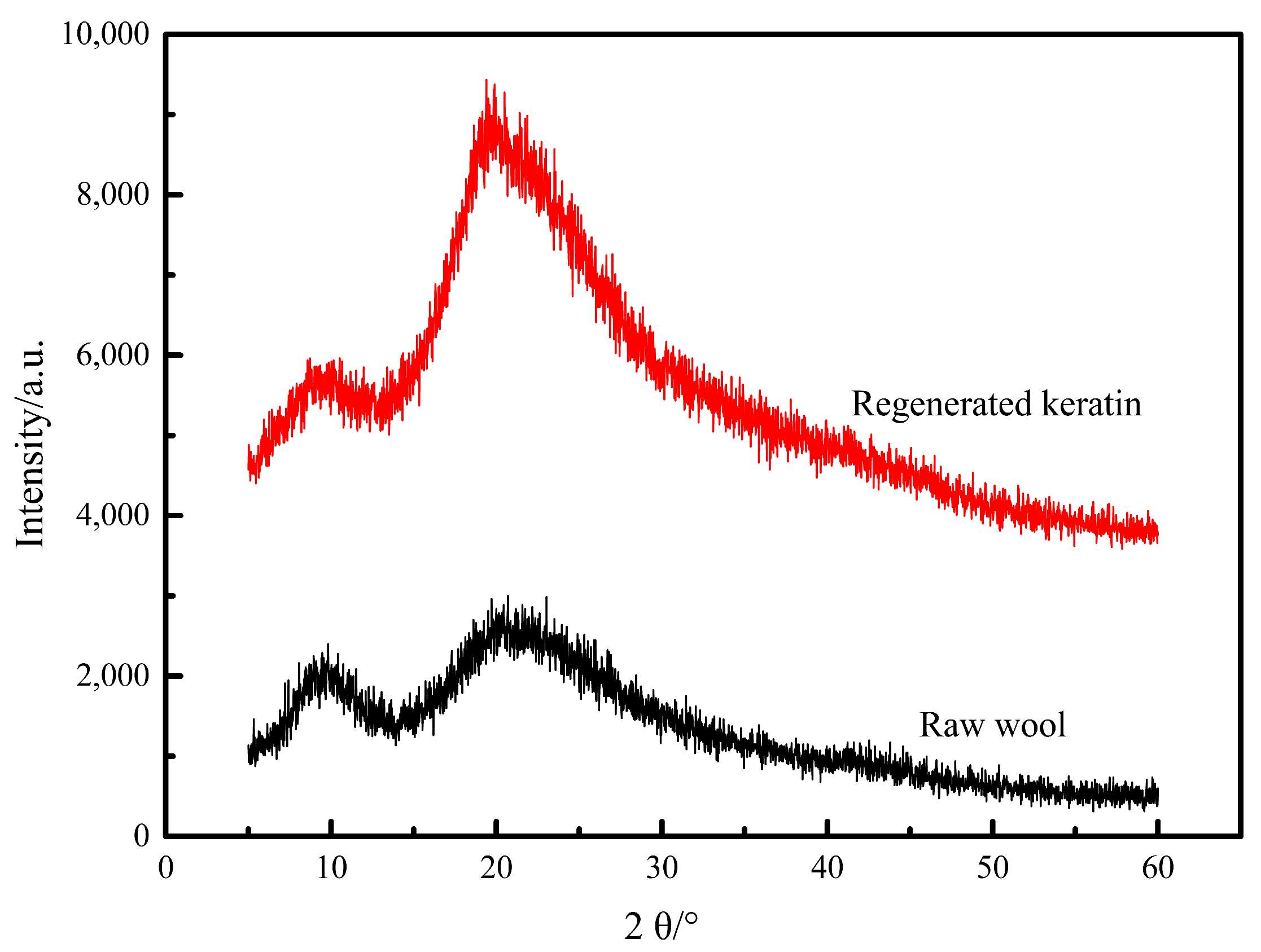

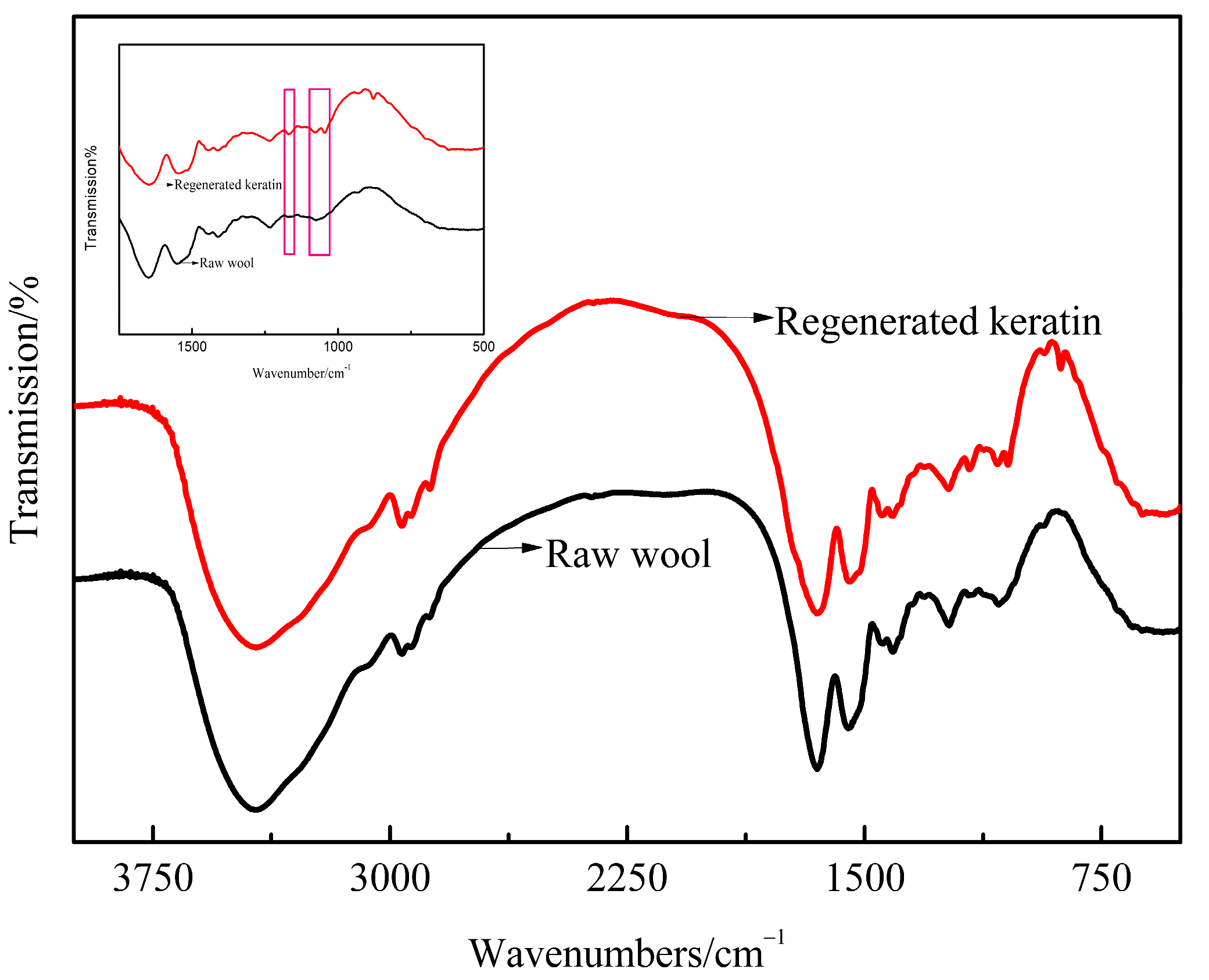
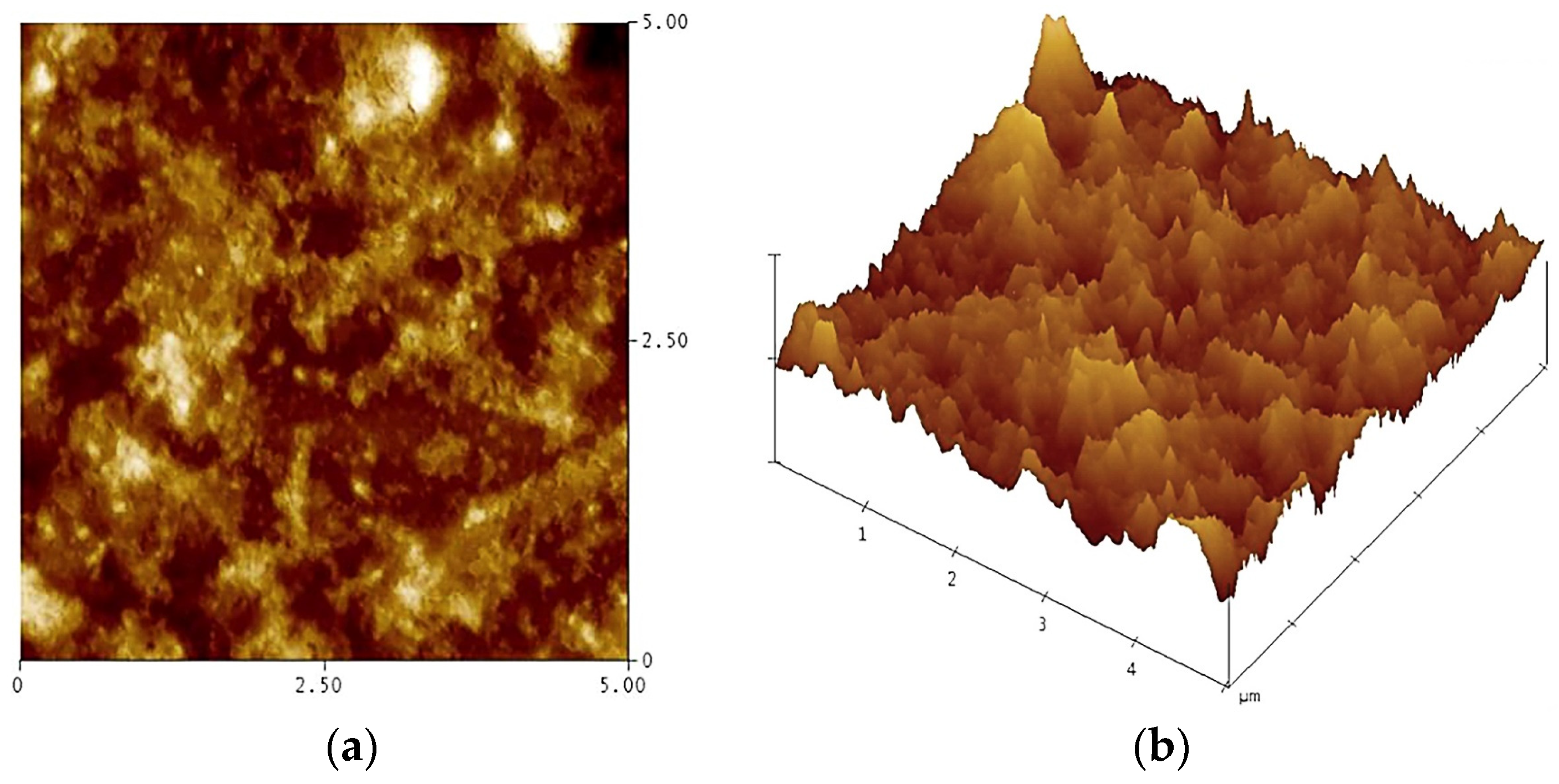
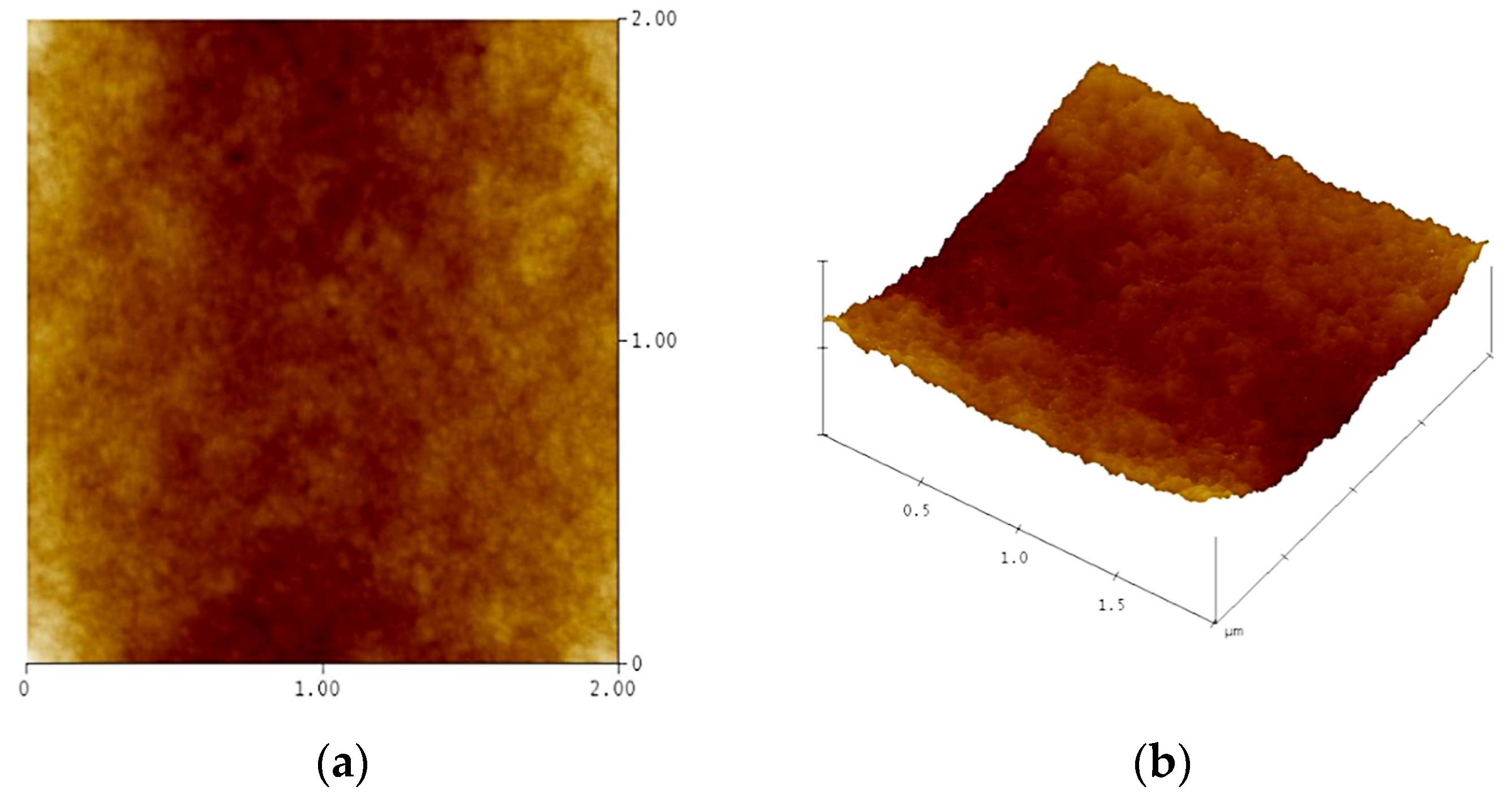
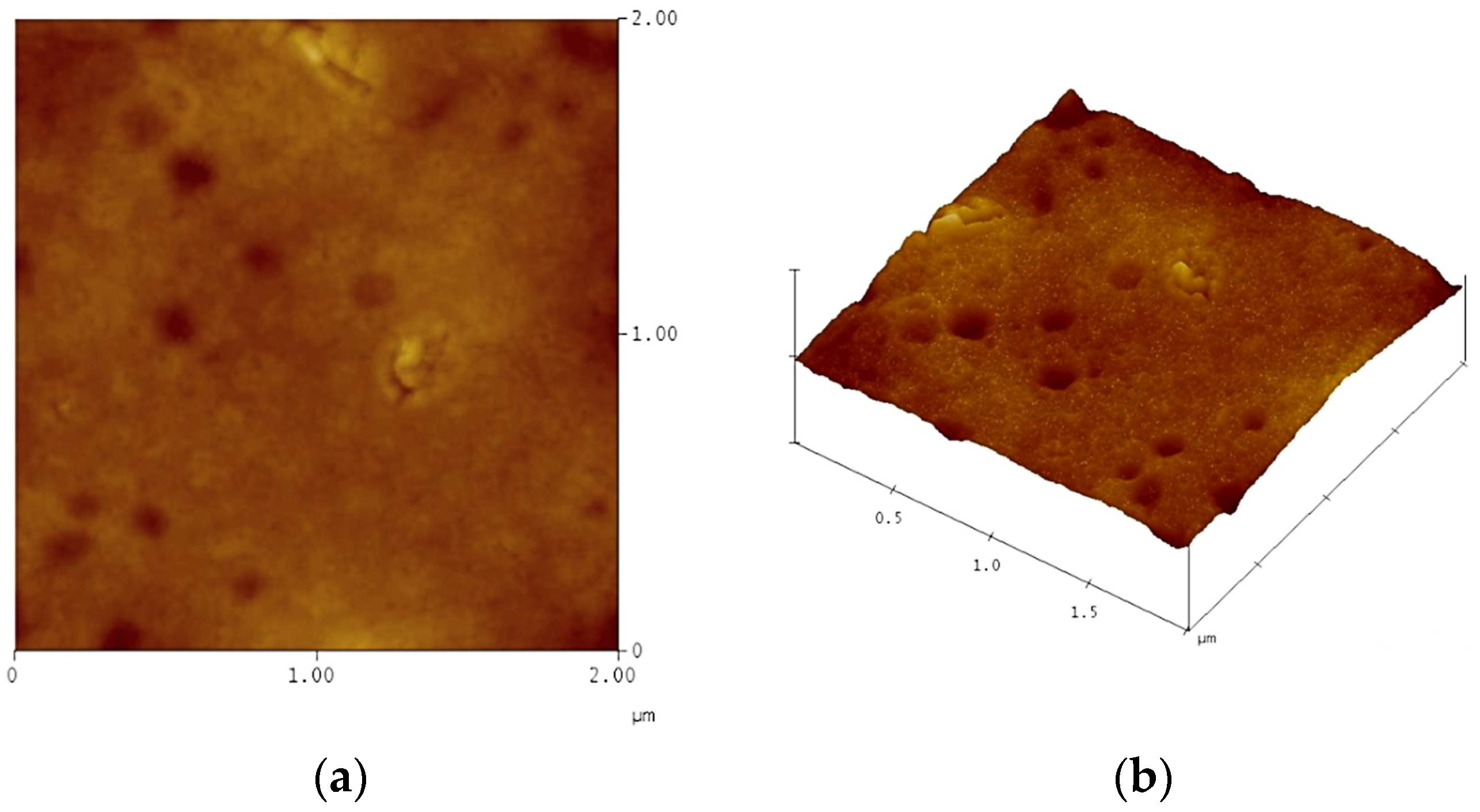
| LiCl mass fraction/% | 0 | 2 | 4 | 6 | 8 | 10 |
| Dissolving time/min | 150 | 112 | 91 | 73 | 58 | 46 |
| Solution | Temperature/°C | Time/min | Solubility/% |
|---|---|---|---|
| LiCl/[Bmim]Cl | 80 | 30 | 4.5 |
| 80 | 60 | 11.5 | |
| 80 | 90 | 13.5 |
Disclaimer/Publisher’s Note: The statements, opinions and data contained in all publications are solely those of the individual author(s) and contributor(s) and not of MDPI and/or the editor(s). MDPI and/or the editor(s) disclaim responsibility for any injury to people or property resulting from any ideas, methods, instructions or products referred to in the content. |
© 2023 by the authors. Licensee MDPI, Basel, Switzerland. This article is an open access article distributed under the terms and conditions of the Creative Commons Attribution (CC BY) license (https://creativecommons.org/licenses/by/4.0/).
Share and Cite
Wang, M.; Zhang, G.; Zhou, J.; Cao, H.; Zheng, J.; Jing, H.; Du, L. Study of [Bmim]Cl/LiCl Co-Solvent Dissolution of Waste Wool. Coatings 2023, 13, 1825. https://doi.org/10.3390/coatings13111825
Wang M, Zhang G, Zhou J, Cao H, Zheng J, Jing H, Du L. Study of [Bmim]Cl/LiCl Co-Solvent Dissolution of Waste Wool. Coatings. 2023; 13(11):1825. https://doi.org/10.3390/coatings13111825
Chicago/Turabian StyleWang, Ming, Ge Zhang, Jinli Zhou, Hanrui Cao, Junjie Zheng, Huan Jing, and Lixin Du. 2023. "Study of [Bmim]Cl/LiCl Co-Solvent Dissolution of Waste Wool" Coatings 13, no. 11: 1825. https://doi.org/10.3390/coatings13111825





